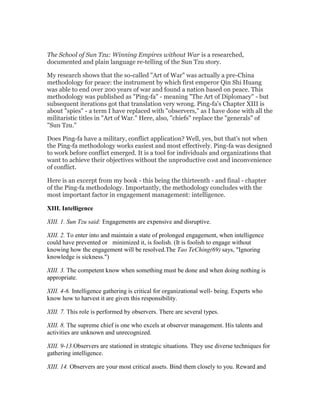
Sun Tzu on Intelligence
- 1. The School of Sun Tzu: Winning Empires without War is a researched, documented and plain language re-telling of the Sun Tzu story. My research shows that the so-called "Art of War" was actually a pre-China methodology for peace: the instrument by which first emperor Qin Shi Huang was able to end over 200 years of war and found a nation based on peace. This methodology was published as "Ping-fa" - meaning "The Art of Diplomacy" - but subsequent iterations got that translation very wrong. Ping-fa's Chapter XIII is about "spies" - a term I have replaced with "observers," as I have done with all the militaristic titles in "Art of War." Here, also, "chiefs" replace the "generals" of "Sun Tzu." Does Ping-fa have a military, conflict application? Well, yes, but that's not when the Ping-fa methodology works easiest and most effectively. Ping-fa was designed to work before conflict emerged. It is a tool for individuals and organizations that want to achieve their objectives without the unproductive cost and inconvenience of conflict. Here is an excerpt from my book - this being the thirteenth - and final - chapter of the Ping-fa methodology. Importantly, the methodology concludes with the most important factor in engagement management: intelligence. XIII. Intelligence XIII. 1. Sun Tzu said: Engagements are expensive and disruptive. XIII. 2. To enter into and maintain a state of prolonged engagement, when intelligence could have prevented or minimized it, is foolish. (It is foolish to engage without knowing how the engagement will be resolved.The Tao TeChing(69) says, "Ignoring knowledge is sickness.") XIII. 3. The competent know when something must be done and when doing nothing is appropriate. XIII. 4-6. Intelligence gathering is critical for organizational well- being. Experts who know how to harvest it are given this responsibility. XIII. 7. This role is performed by observers. There are several types. XIII. 8. The supreme chief is one who excels at observer management. His talents and activities are unknown and unrecognized. XIII. 9-13.Observers are stationed in strategic situations. They use diverse techniques for gathering intelligence. XIII. 14. Observers are your most critical assets. Bind them closely to you. Reward and
- 2. cloak them well. (They are the "picked troops" in the front ranks of Qin Shih Huang's terra-cotta "army.") XIII. 15. The chief must have a natural talent for instruction and deployment. XIII. 16. Observers need to know that the object of the exercise is effecting change for the benefit of the whole. XIII. 17. A report of people and events is one thing. What that report means could be something else altogether. XIII. 18. That you use observers, how, and for what reasons must never be revealed. XIII. 19. Observers are critical to the engagement and the organization. Everything depends upon their discretion. XIII. 20. Charge your observers with discovering who is in charge, and who the contacts and confidants of those in charge are. All these details are of importance. XIII. 21-25.Your best observers are those who are in the employ of the other. XIII. 26-27. Organizational management requires an effective intelligence system that provides the data that the chief may assess to determine when action, and inaction, is warranted.
